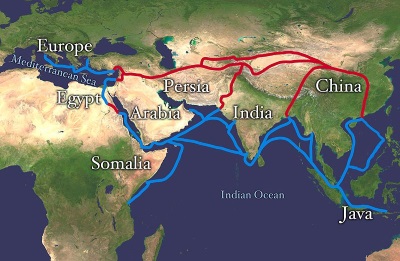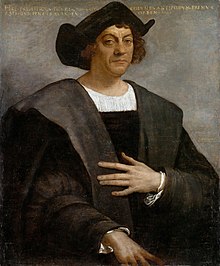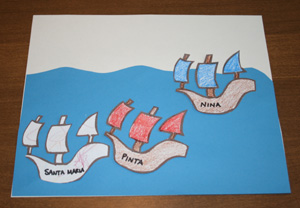Christopher Columbus -- School-age
Christopher Columbus
Christopher Columbus was a master navigator, admiral, and famous explorer. Sponsored by King Ferdinand and Queen Isabella of Spain, his four voyages across the Atlantic Ocean opened the way for European exploration and colonists, for others with the courage to sail to the Americas.
In fourteen hundred ninety-two, Columbus sailed the ocean blue.
Christopher Columbus was born in 1451 in the Italian port city of Genoa. His four voyages of discovery opened up an unknown world - the Americas - to the people of Europe. Columbus's travel's altered Europe and the Americas (known as the New World). After his voyages, animals, plants and other items would be shared between Europe and the Americas. People from Europe would travel to the new world and settle in the new world.
Columbus died in 1506 never understanding the importance of his voyage. That he was an explorer who brought two worlds together. He believed he had found a new route to the Indies. But Columbus charted a pathway between two different worlds. In doing so he changed the lives of people in Europe and the Americas.
Video
Trade
Europeans used spices from Asia to preserve foods and keep them from spoiling. The Silk road was a trade land route that went from China to Eastern Europe. Using Silk Road was expensive, dangerous and parts were frequently closed due to various wars. Constantinople (today Istanbul) was the link between Europe and the Silk road. In 1453, Constantinople fell to the Ottoman Turks, who gained control of the trade route. Travel for Europeans on the Silk Road ended with the rise of the Ottoman Turks and the decline of other powers in Central Asia (Mongols).
European nations began looking for a sea route. The Portuguese made use of the knowledge Europeans had about the world in the 15th century. Portugal would send explorers to find a route to Asia sailing east around the horn of Africa. Sailors in the 15th century were afraid of sea monsters and boiling hot water at the Equator, so progress was slow.

Going West To Reach The East
Columbus would turn the idea around - sail west to reach the East. Columbus idea was to sail west to find a shortcut to the Indies. He thought only the Atlantic Ocean lay between Europe and the East. Portugal refused to finance the exploration trip. Columbus convinced Spain’s King Ferdinand and Queen Isabella to finance the exploration trip. The small fleet set sail on August 3, 1492. After about two months on the Atlantic Ocean, Christopher Columbus and his crew landed on the island of Hispaniola on October 12, 1492.

Video
The Nina, the Pinta, and the Santa Maria
The Santa Maria was Christopher Columbus' flagship on his first voyage. The Santa Maria was 117 feet (36m) long. On the first voyage, the Santa Maria ran aground and had to be abandoned on Christmas Eve 1492 in Hispaniola. No room could be found on the other ships for 39 sailors. The timbers of the abandoned ship were used to build a fort, La Navidad.
The Nina and the Pinta were light sailing caravel ships. The Nina was the smallest ship in the fleet. From 1988-1991, an American engineer and maritime historian, John Patrick Sarsfield,built the first historically correct replica of the Nina. >
Sites to See
Nina, Pinta, and Santa Maria color page.
Columbus Day color page (ship and sentence with date).
Christopher Columbus word printables (word search, color pages, and more.
Go West With Columbus
Print, color, and play the game.
Fun Fact
Columbus brought horses to the new world on his second voyage in 1493.

 .
.



